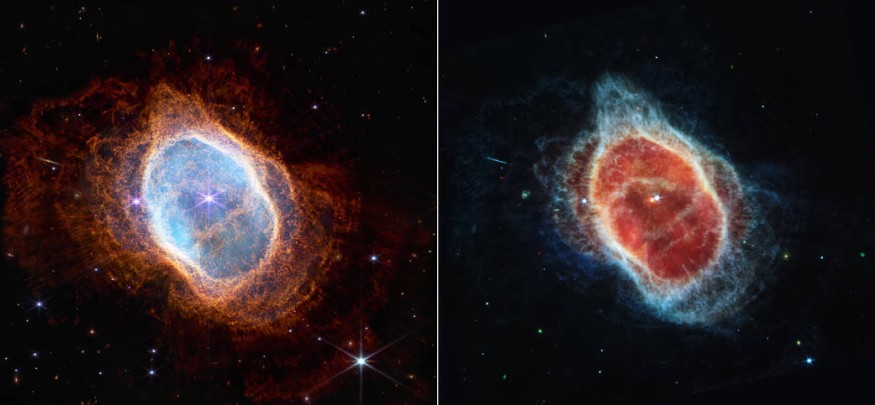NASA shared two photos of the Southern Ring Nebula (NGC 3132), a massive cloud of gas and dust located 2,000 light-years from Earth.
Webb's infrared vision, which allows it to see through the nebula's cosmic dust, also made it possible to observe something previously unseen: a side view of a distant galaxy lying in the image's backdrop.

NASA James Webb Space Telescope Reveals Lovely Southern Ring Nebula in High Resolution
A blazing white dwarf located about 2,000 light-years from Earth has produced a celestial beauty. The Southern Ring Nebula, also called NGC 3132, was created due to the dying star losing its outer layers and irradiating them with UV rays.
Thanks to the incredible capabilities of NASA's James Webb Space Telescope, fans can now see the "dying star" in infrared with the best resolution.
The white dwarf and its companion star may be seen plainly in mid-infrared, blanketed in dust and appearing red. Waves of material expelled by the former red giant can also be observed, IFLScience pointed out.
In the photo, the Southern Ring Nebula almost appears to be facing Earth. Still, if it could be rotated to be seen edge-on, its three-dimensional shape would be more clearly seen as two bowls joined at the bottom, opening apart with a sizable hole in the middle.
According to Astronomy Now, the NGC 3132's appearance is influenced by the star's brightness. The pair "stirs the pot" of gas and dust as it continues to orbit one another, producing uneven patterns.
Every shell represents a period during which the mass of the fainter star was lost. The largest gas shells were those closer to the image's margins and were expelled first. The ones that are closest to the star are the most recent. These ejections can be tracked, and the system's history can be examined.
The planetary nebula is surrounded by incredibly thin light rays, according to observations made with NIRCam. Where there are openings in the gas and dust, starlight from the center stars radiates out, much like sunshine passing through openings in a cloud.
About NGC 3132
Additional details regarding the galaxy that photobombed the Southern Ring Nebula (NGC 3132) have not yet been released by Webb researchers.
Alex Lockwood, a project scientist, said as he shared the nebula's two new images on Tuesday (via PBS News Hour) that the "near-infrared image is - wow."
The Southern Ring, also known as the "Eight-Burst" nebula, is a vibrant shell of gas and dust that a dying star ejected into space.
Klaus Pontoppidan, the project scientist for JWST at NASA's Goddard Space Flight Center, told reporters (per Business Insider) after revealing the photographs that "As the star is dying, in its last dying throes, it starts to shake. It pulsates. And at the end of that, poof, it comes out."
Pontoppidan compares The Southern Ring to having geological layers.
The new images not only show the fading star in more detail but also make visible a second star that was previously hidden from view and is gravitationally tied to the first. According to astronomers, closely examining the once-hidden stars will enable them to comprehend how they affect the gas and dust clouds.
Check out more news and information on Space in Science Times.
© 2026 ScienceTimes.com All rights reserved. Do not reproduce without permission. The window to the world of Science Times.












